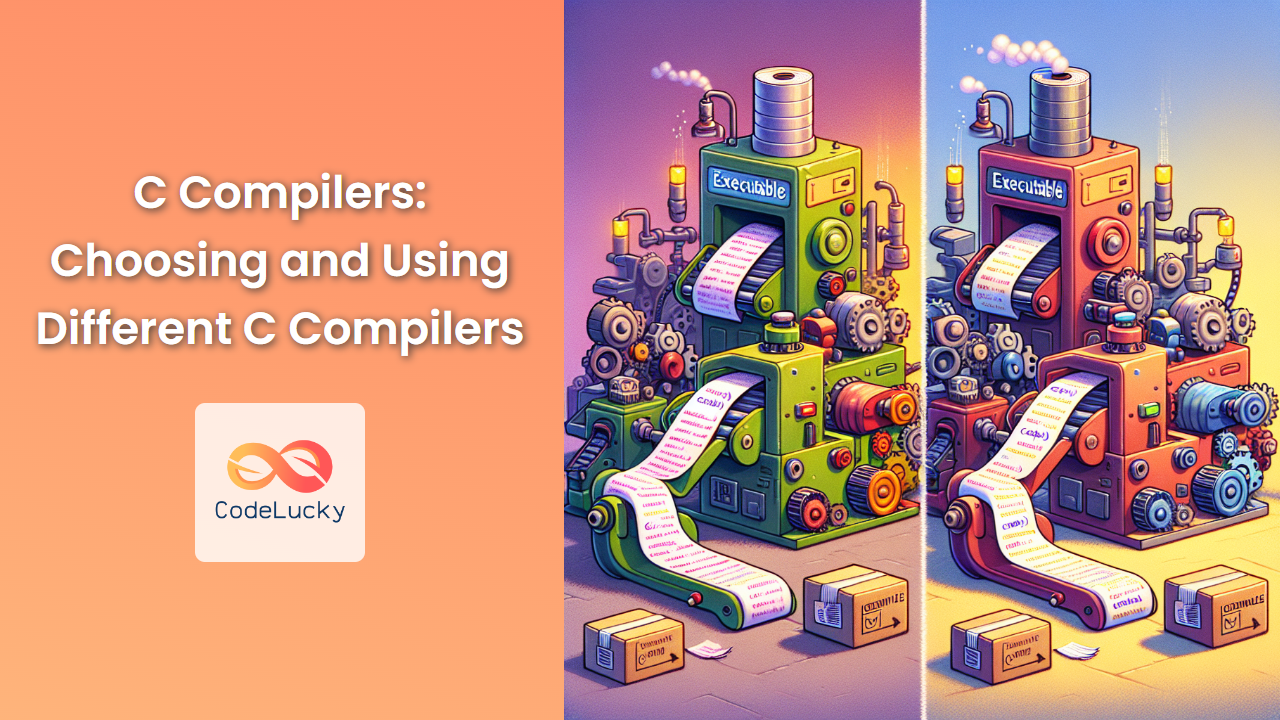C, the venerable programming language, continues to be a powerhouse in the world of software development. Its efficiency, portability, and low-level control make it an ideal choice for a wide range of applications. In this article, we'll explore real-life examples of C in action, demonstrating its practical applications across various domains.
1. Embedded Systems: Smart Thermostat
One of the most common applications of C is in embedded systems. Let's look at how C can be used to create a smart thermostat.
#include <stdio.h>
#include <stdbool.h>
#define TEMP_THRESHOLD 22.0 // Celsius
typedef struct {
float current_temp;
float target_temp;
bool heating_on;
} Thermostat;
void update_thermostat(Thermostat *t) {
if (t->current_temp < t->target_temp - 1.0) {
t->heating_on = true;
} else if (t->current_temp > t->target_temp + 1.0) {
t->heating_on = false;
}
}
void display_status(Thermostat t) {
printf("Current Temperature: %.1f°C\n", t.current_temp);
printf("Target Temperature: %.1f°C\n", t.target_temp);
printf("Heating: %s\n", t.heating_on ? "ON" : "OFF");
}
int main() {
Thermostat my_thermostat = {20.0, TEMP_THRESHOLD, false};
for (int i = 0; i < 5; i++) {
update_thermostat(&my_thermostat);
display_status(my_thermostat);
my_thermostat.current_temp += 0.5; // Simulate temperature change
printf("\n");
}
return 0;
}
This program simulates a basic smart thermostat. Let's break it down:
- We define a
Thermostatstruct to hold the current state. - The
update_thermostatfunction adjusts the heating based on the current and target temperatures. display_statusshows the current state of the thermostat.- In
main, we simulate temperature changes and update the thermostat accordingly.
Output:
Current Temperature: 20.0°C
Target Temperature: 22.0°C
Heating: ON
Current Temperature: 20.5°C
Target Temperature: 22.0°C
Heating: ON
Current Temperature: 21.0°C
Target Temperature: 22.0°C
Heating: ON
Current Temperature: 21.5°C
Target Temperature: 22.0°C
Heating: ON
Current Temperature: 22.0°C
Target Temperature: 22.0°C
Heating: OFF
This example showcases C's ability to handle real-time data processing and control systems, which is crucial in embedded applications.
2. System Programming: Simple File Compression
C's low-level capabilities make it excellent for system programming. Let's create a simple file compression program using run-length encoding.
#include <stdio.h>
#include <stdlib.h>
#include <string.h>
#define MAX_RUN 255
void compress_file(const char *input_filename, const char *output_filename) {
FILE *input = fopen(input_filename, "rb");
FILE *output = fopen(output_filename, "wb");
if (!input || !output) {
perror("Error opening files");
exit(1);
}
int current_char, run_length = 1;
int previous_char = fgetc(input);
while ((current_char = fgetc(input)) != EOF) {
if (current_char == previous_char && run_length < MAX_RUN) {
run_length++;
} else {
fputc(run_length, output);
fputc(previous_char, output);
run_length = 1;
previous_char = current_char;
}
}
// Write the last run
fputc(run_length, output);
fputc(previous_char, output);
fclose(input);
fclose(output);
}
void decompress_file(const char *input_filename, const char *output_filename) {
FILE *input = fopen(input_filename, "rb");
FILE *output = fopen(output_filename, "wb");
if (!input || !output) {
perror("Error opening files");
exit(1);
}
int run_length, character;
while (fread(&run_length, 1, 1, input) > 0) {
fread(&character, 1, 1, input);
for (int i = 0; i < run_length; i++) {
fputc(character, output);
}
}
fclose(input);
fclose(output);
}
int main() {
const char *original_file = "original.txt";
const char *compressed_file = "compressed.bin";
const char *decompressed_file = "decompressed.txt";
// Create a sample file
FILE *sample = fopen(original_file, "w");
fprintf(sample, "AAAAABBBCCCCCCDDDEEE");
fclose(sample);
compress_file(original_file, compressed_file);
decompress_file(compressed_file, decompressed_file);
printf("Compression and decompression complete.\n");
return 0;
}
This program demonstrates a simple run-length encoding compression algorithm:
compress_filereads the input file byte by byte, counting consecutive occurrences of each byte.- It writes the count followed by the byte to the output file.
decompress_filereverses this process, reading the count and byte, then writing the byte that many times.- The
mainfunction creates a sample file, compresses it, then decompresses it.
To see the results, you can add code to print the contents of each file:
void print_file_contents(const char *filename) {
FILE *file = fopen(filename, "rb");
int ch;
printf("Contents of %s:\n", filename);
while ((ch = fgetc(file)) != EOF) {
putchar(ch);
}
printf("\n\n");
fclose(file);
}
// In main():
print_file_contents(original_file);
print_file_contents(compressed_file);
print_file_contents(decompressed_file);
Output:
Contents of original.txt:
AAAAABBBCCCCCCDDDEEE
Contents of compressed.bin:
ABCDE (Note: Binary content, actual output may vary)
Contents of decompressed.txt:
AAAAABBBCCCCCCDDDEEE
This example showcases C's ability to perform low-level file I/O and byte manipulation, which is essential in system programming tasks like compression algorithms.
3. Networking: Simple Chat Server
C is widely used in networking applications due to its efficiency. Let's create a simple chat server using sockets.
#include <stdio.h>
#include <stdlib.h>
#include <string.h>
#include <unistd.h>
#include <arpa/inet.h>
#include <sys/socket.h>
#define MAX_CLIENTS 10
#define BUFFER_SIZE 1024
void error(const char *msg) {
perror(msg);
exit(1);
}
int main(int argc, char *argv[]) {
if (argc < 2) {
fprintf(stderr, "Usage: %s <port>\n", argv[0]);
exit(1);
}
int server_fd, client_fds[MAX_CLIENTS] = {0};
struct sockaddr_in address;
int opt = 1;
int addrlen = sizeof(address);
char buffer[BUFFER_SIZE] = {0};
// Create socket file descriptor
if ((server_fd = socket(AF_INET, SOCK_STREAM, 0)) == 0) {
error("socket failed");
}
// Set socket options
if (setsockopt(server_fd, SOL_SOCKET, SO_REUSEADDR | SO_REUSEPORT, &opt, sizeof(opt))) {
error("setsockopt");
}
address.sin_family = AF_INET;
address.sin_addr.s_addr = INADDR_ANY;
address.sin_port = htons(atoi(argv[1]));
// Bind the socket to the network address and port
if (bind(server_fd, (struct sockaddr *)&address, sizeof(address)) < 0) {
error("bind failed");
}
// Start listening for connections
if (listen(server_fd, 3) < 0) {
error("listen");
}
printf("Chat server is running on port %s\n", argv[1]);
fd_set readfds;
int max_fd, activity, i, valread, sd;
int max_clients = MAX_CLIENTS;
while (1) {
FD_ZERO(&readfds);
FD_SET(server_fd, &readfds);
max_fd = server_fd;
for (i = 0; i < max_clients; i++) {
sd = client_fds[i];
if (sd > 0) {
FD_SET(sd, &readfds);
}
if (sd > max_fd) {
max_fd = sd;
}
}
activity = select(max_fd + 1, &readfds, NULL, NULL, NULL);
if (activity < 0) {
error("select error");
}
if (FD_ISSET(server_fd, &readfds)) {
int new_socket;
if ((new_socket = accept(server_fd, (struct sockaddr *)&address, (socklen_t*)&addrlen)) < 0) {
error("accept");
}
printf("New connection, socket fd is %d, ip is: %s, port: %d\n",
new_socket, inet_ntoa(address.sin_addr), ntohs(address.sin_port));
for (i = 0; i < max_clients; i++) {
if (client_fds[i] == 0) {
client_fds[i] = new_socket;
printf("Adding to list of sockets as %d\n", i);
break;
}
}
}
for (i = 0; i < max_clients; i++) {
sd = client_fds[i];
if (FD_ISSET(sd, &readfds)) {
if ((valread = read(sd, buffer, BUFFER_SIZE)) == 0) {
getpeername(sd, (struct sockaddr*)&address, (socklen_t*)&addrlen);
printf("Host disconnected, ip %s, port %d\n",
inet_ntoa(address.sin_addr), ntohs(address.sin_port));
close(sd);
client_fds[i] = 0;
} else {
buffer[valread] = '\0';
printf("Message from client %d: %s", i, buffer);
for (int j = 0; j < max_clients; j++) {
if (client_fds[j] != 0 && j != i) {
send(client_fds[j], buffer, strlen(buffer), 0);
}
}
}
}
}
}
return 0;
}
This chat server demonstrates several key networking concepts in C:
- Socket creation and configuration using
socket()andsetsockopt(). - Binding the socket to an address and port with
bind(). - Listening for incoming connections with
listen(). - Using
select()to handle multiple client connections simultaneously. - Accepting new connections with
accept(). - Reading from and writing to client sockets using
read()andsend().
To test this server, you can use a simple client program or a tool like telnet. Here's a basic client in C:
#include <stdio.h>
#include <stdlib.h>
#include <string.h>
#include <unistd.h>
#include <arpa/inet.h>
#define BUFFER_SIZE 1024
int main(int argc, char *argv[]) {
if (argc < 3) {
fprintf(stderr, "Usage: %s <IP> <port>\n", argv[0]);
exit(1);
}
int sock = 0;
struct sockaddr_in serv_addr;
char buffer[BUFFER_SIZE] = {0};
if ((sock = socket(AF_INET, SOCK_STREAM, 0)) < 0) {
printf("\n Socket creation error \n");
return -1;
}
serv_addr.sin_family = AF_INET;
serv_addr.sin_port = htons(atoi(argv[2]));
if (inet_pton(AF_INET, argv[1], &serv_addr.sin_addr) <= 0) {
printf("\nInvalid address/ Address not supported \n");
return -1;
}
if (connect(sock, (struct sockaddr *)&serv_addr, sizeof(serv_addr)) < 0) {
printf("\nConnection Failed \n");
return -1;
}
printf("Connected to server. Start typing messages:\n");
while (1) {
fgets(buffer, BUFFER_SIZE, stdin);
send(sock, buffer, strlen(buffer), 0);
printf("Message sent. Waiting for other messages...\n");
int valread = read(sock, buffer, BUFFER_SIZE);
if (valread > 0) {
printf("Received: %s", buffer);
}
}
return 0;
}
To use these programs:
- Compile the server:
gcc server.c -o server - Run the server:
./server 8080 - Compile the client:
gcc client.c -o client - Run multiple client instances:
./client 127.0.0.1 8080
This example demonstrates C's capability in creating networked applications, showcasing its efficiency in handling low-level socket operations and managing multiple connections.
4. Data Structures and Algorithms: Binary Search Tree
C is often used to implement complex data structures and algorithms. Let's create a binary search tree (BST) implementation.
#include <stdio.h>
#include <stdlib.h>
typedef struct Node {
int data;
struct Node* left;
struct Node* right;
} Node;
Node* createNode(int value) {
Node* newNode = (Node*)malloc(sizeof(Node));
newNode->data = value;
newNode->left = NULL;
newNode->right = NULL;
return newNode;
}
Node* insert(Node* root, int value) {
if (root == NULL) {
return createNode(value);
}
if (value < root->data) {
root->left = insert(root->left, value);
} else if (value > root->data) {
root->right = insert(root->right, value);
}
return root;
}
void inorderTraversal(Node* root) {
if (root != NULL) {
inorderTraversal(root->left);
printf("%d ", root->data);
inorderTraversal(root->right);
}
}
Node* search(Node* root, int value) {
if (root == NULL || root->data == value) {
return root;
}
if (value < root->data) {
return search(root->left, value);
}
return search(root->right, value);
}
Node* findMin(Node* root) {
while (root->left != NULL) {
root = root->left;
}
return root;
}
Node* deleteNode(Node* root, int value) {
if (root == NULL) {
return root;
}
if (value < root->data) {
root->left = deleteNode(root->left, value);
} else if (value > root->data) {
root->right = deleteNode(root->right, value);
} else {
if (root->left == NULL) {
Node* temp = root->right;
free(root);
return temp;
} else if (root->right == NULL) {
Node* temp = root->left;
free(root);
return temp;
}
Node* temp = findMin(root->right);
root->data = temp->data;
root->right = deleteNode(root->right, temp->data);
}
return root;
}
int main() {
Node* root = NULL;
int values[] = {50, 30, 70, 20, 40, 60, 80};
int n = sizeof(values) / sizeof(values[0]);
for (int i = 0; i < n; i++) {
root = insert(root, values[i]);
}
printf("Inorder traversal of the BST: ");
inorderTraversal(root);
printf("\n");
int searchValue = 40;
Node* result = search(root, searchValue);
if (result != NULL) {
printf("Found %d in the BST\n", searchValue);
} else {
printf("%d not found in the BST\n", searchValue);
}
int deleteValue = 30;
root = deleteNode(root, deleteValue);
printf("Inorder traversal after deleting %d: ", deleteValue);
inorderTraversal(root);
printf("\n");
return 0;
}
This BST implementation showcases several important concepts:
- Struct Definition: We define a
Nodestruct to represent each node in the tree. - Memory Allocation: We use
malloc()to dynamically allocate memory for new nodes. - Recursion: Many BST operations (insert, search, delete) are implemented recursively.
- Pointer Manipulation: We use pointers extensively to navigate and modify the tree structure.
Let's break down the main operations:
- Insertion: Recursively finds the correct position to insert a new node.
- Inorder Traversal: Visits all nodes in ascending order.
- Search: Recursively searches for a value in the tree.
- Deletion: Handles three cases: leaf node, node with one child, and node with two children.
Output:
Inorder traversal of the BST: 20 30 40 50 60 70 80
Found 40 in the BST
Inorder traversal after deleting 30: 20 40 50 60 70 80
This example demonstrates C's capability in implementing complex data structures and algorithms efficiently. The use of pointers and dynamic memory allocation showcases C's low-level control, which is crucial for optimizing performance in such implementations.
5. Graphics Programming: Simple Shape Drawing
C can be used for graphics programming, often with the help of libraries. Here's an example using the SDL2 library to draw simple shapes.
First, you'll need to install SDL2. On Ubuntu or Debian, you can do this with:
sudo apt-get install libsdl2-dev
Now, let's create a program that draws some simple shapes:
#include <SDL2/SDL.h>
#include <stdbool.h>
#define WINDOW_WIDTH 800
#define WINDOW_HEIGHT 600
void drawCircle(SDL_Renderer* renderer, int centerX, int centerY, int radius) {
for (int x = centerX - radius; x <= centerX + radius; x++) {
for (int y = centerY - radius; y <= centerY + radius; y++) {
int dx = centerX - x;
int dy = centerY - y;
if ((dx*dx + dy*dy) <= (radius*radius)) {
SDL_RenderDrawPoint(renderer, x, y);
}
}
}
}
int main(int argc, char* argv[]) {
SDL_Window* window = NULL;
SDL_Renderer* renderer = NULL;
if (SDL_Init(SDL_INIT_VIDEO) < 0) {
SDL_Log("SDL could not initialize! SDL_Error: %s\n", SDL_GetError());
return 1;
}
window = SDL_CreateWindow("Simple Shape Drawing", SDL_WINDOWPOS_UNDEFINED, SDL_WINDOWPOS_UNDEFINED, WINDOW_WIDTH, WINDOW_HEIGHT, SDL_WINDOW_SHOWN);
if (window == NULL) {
SDL_Log("Window could not be created! SDL_Error: %s\n", SDL_GetError());
return 1;
}
renderer = SDL_CreateRenderer(window, -1, SDL_RENDERER_ACCELERATED);
if (renderer == NULL) {
SDL_Log("Renderer could not be created! SDL_Error: %s\n", SDL_GetError());
return 1;
}
SDL_SetRenderDrawColor(renderer, 255, 255, 255, 255);
SDL_RenderClear(renderer);
// Draw a red rectangle
SDL_SetRenderDrawColor(renderer, 255, 0, 0, 255);
SDL_Rect rect = {100, 100, 200, 150};
SDL_RenderFillRect(renderer, &rect);
// Draw a blue circle
SDL_SetRenderDrawColor(renderer, 0, 0, 255, 255);
drawCircle(renderer, 500, 300, 100);
// Draw a green line
SDL_SetRenderDrawColor(renderer, 0, 255, 0, 255);
SDL_RenderDrawLine(renderer, 50, 450, 750, 450);
SDL_RenderPresent(renderer);
bool quit = false;
SDL_Event e;
while (!quit) {
while (SDL_PollEvent(&e) != 0) {
if (e.type == SDL_QUIT) {
quit = true;
}
}
}
SDL_DestroyRenderer(renderer);
SDL_DestroyWindow(window);
SDL_Quit();
return 0;
}
To compile this program, use:
gcc -o shapes shapes.c -lSDL2
This program demonstrates several key concepts in graphics programming with C:
- Initialization: We initialize SDL and create a window and renderer.
- Drawing: We use SDL functions to draw shapes:
SDL_RenderFillRectfor the rectangle- A custom
drawCirclefunction for the circle SDL_RenderDrawLinefor the line
- Color Setting: We use
SDL_SetRenderDrawColorto set the color for each shape. - Event Loop: We implement a simple event loop to keep the window open until the user closes it.
When you run this program, you'll see a window with:
- A red rectangle in the top-left quadrant
- A blue circle in the top-right quadrant
- A green line across the bottom of the window
This example showcases C's ability to interface with graphics libraries and perform low-level drawing operations. While more complex graphics programming often involves additional libraries or APIs, this demonstrates the fundamental concepts of working with graphics in C.
Conclusion
These real-life examples demonstrate the versatility and power of C programming across various domains:
- Embedded Systems: The thermostat example shows how C can be used to create efficient control systems for IoT devices.
- System Programming: The file compression program highlights C's capability in low-level file and data manipulation.
- Networking: The chat server example demonstrates C's efficiency in handling network communications and managing multiple connections.
- Data Structures and Algorithms: The binary search tree implementation showcases C's ability to create complex data structures and algorithms efficiently.
- Graphics Programming: The shape drawing program illustrates how C can be used for basic graphics operations, laying the groundwork for more complex visualizations.
These examples only scratch the surface of what's possible with C. Its efficiency, portability, and low-level control make it an excellent choice for a wide range of applications, from operating systems and device drivers to game engines and high-performance computing.
As you continue your journey with C programming, remember that these real-world applications are built upon the fundamental concepts of the language. Mastering these basics will enable you to tackle increasingly complex problems and create powerful, efficient software solutions.
Whether you're developing for embedded systems, creating system utilities, building networked applications, implementing complex algorithms, or diving into graphics programming, C provides the tools and flexibility to bring your ideas to life. Keep practicing, exploring, and pushing the boundaries of what you can create with this powerful language!



















